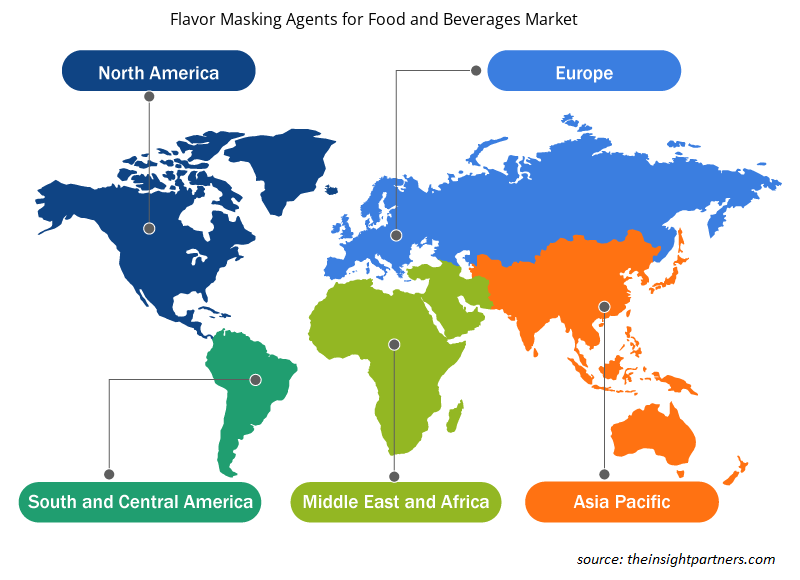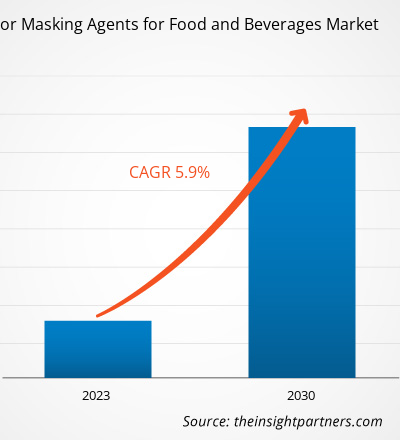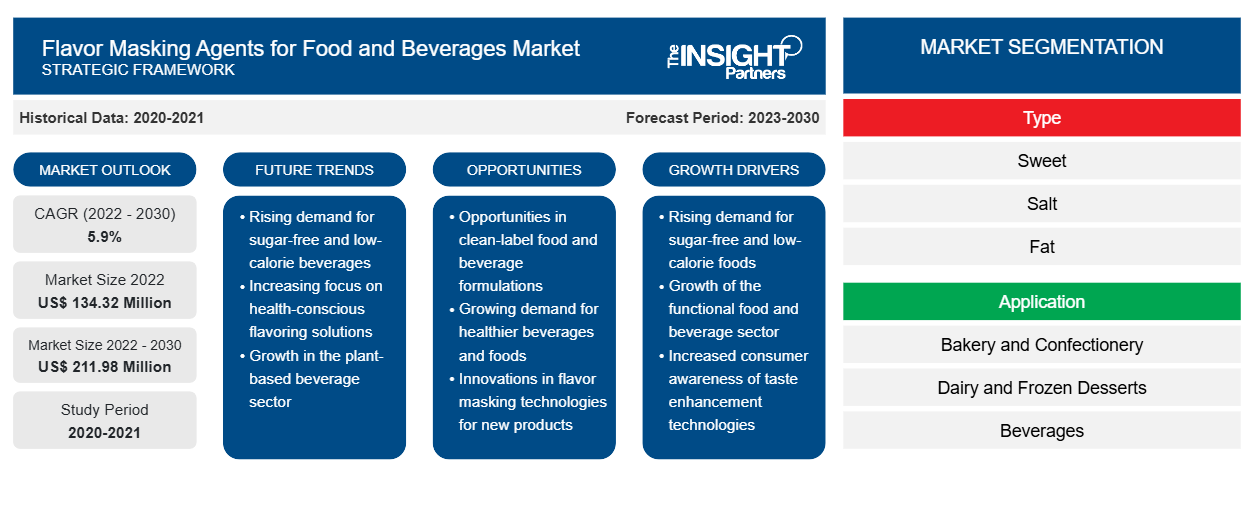[Rapporto di ricerca] Si prevede che le dimensioni del mercato degli agenti mascheranti per alimenti e bevande cresceranno da 134,32 milioni di dollari nel 2022 a 211,98 milioni di dollari entro il 2030. Si prevede che il mercato registrerà un CAGR del 5,9% dal 2022 al 2030.
Approfondimenti di mercato e opinioni degli analisti:
Gli agenti mascheranti del sapore sono ingredienti o additivi utilizzati per mascherare sapori indesiderati in vari alimenti e bevande come prodotti da forno e dolciumi, latticini e dessert surgelati, alternative alla carne, alternative al latte, prodotti a base di carne e pesce e snack salati. Gli agenti migliorano la gradevolezza del cibo mascherando le note sgradevoli come amarezza, dolcezza, sapidità, acidità, sapore di grasso, note sgradevoli metalliche, gessosità, sapori di fagioli ed erba e altri. Gli agenti mascheranti del sapore includono anche vari sistemi di sapore, tra cui modulatori del gusto, soppressori dell'amarezza, soppressori della dolcezza e modulatori del grasso.
Fattori di crescita e sfide:
Molti alimenti trasformati fortificati come prodotti lattiero-caseari, prodotti a base di carne e prodotti da forno e dolciari contengono vitamine, proteine e altri ingredienti funzionali con odori e sapori sgradevoli. Gli agenti mascheranti sono ampiamente utilizzati in questi prodotti per ottenere il sapore e il gusto desiderati. Inoltre, gli agenti consentono una riduzione del contenuto di zucchero, sale e grassi degli alimenti trasformati. Pertanto, un aumento del consumo di alimenti trasformati spinge la necessità di agenti mascheranti. Inoltre, il crescente interesse dei consumatori per stili di vita più sani spinge la domanda di alimenti e bevande fortificati, funzionali e altri alimenti e bevande funzionali e convenienti, come prodotti con meno zucchero. Tuttavia, i benefici funzionali potenziati possono ostacolare il gusto e i sapori del prodotto finale. Pertanto, per ottenere il sapore desiderato, i produttori di alimenti funzionali e convenienti utilizzano agenti mascheranti. Ad esempio, gli agenti mascheranti sono utilizzati in modo significativo nei prodotti alimentari a base di proteine per eliminare o neutralizzare il sapore sgradevole o indesiderato delle proteine. Pertanto, un'ampia gamma di applicazioni di agenti mascheranti il sapore in vari alimenti e bevande stimola la crescita del mercato globale degli agenti mascheranti il sapore per alimenti e bevande .
Personalizza questo report in base alle tue esigenze
Riceverai la personalizzazione gratuita di qualsiasi report, comprese parti di questo report, o analisi a livello nazionale, pacchetto dati Excel, oltre a usufruire di grandi offerte e sconti per start-up e università
-
Scopri le principali tendenze di mercato in questo rapporto.Questo campione GRATUITO includerà analisi di dati che spaziano dalle tendenze di mercato alle stime e alle previsioni.
Segmentazione e ambito del report:
Il mercato globale degli agenti mascheranti per alimenti e bevande è segmentato in base a tipo, applicazione e geografia. Il mercato degli agenti mascheranti per alimenti e bevande, per tipo, è segmentato in dolce, salato, grasso, amaro e altri. In base all'applicazione, il mercato è segmentato in prodotti da forno e dolciumi; latticini e dessert surgelati ; bevande; carne, pollame e frutti di mare; sostituti della carne; alternative ai latticini ; pasti RTE e RTC; e altri. Il mercato degli agenti mascheranti per alimenti e bevande, in base alla geografia, è segmentato in Nord America (Stati Uniti, Canada e Messico), Europa (Germania, Francia, Italia, Regno Unito, Russia e resto d'Europa), Asia Pacifico (Australia, Cina, Giappone, India, Corea del Sud e resto dell'Asia Pacifico), Medio Oriente e Africa (Sudafrica, Arabia Saudita, Emirati Arabi Uniti e resto del Medio Oriente e Africa) e Sud e Centro America (Brasile, Argentina e resto del Sud e Centro America).
Analisi segmentale:
In base al tipo, il mercato degli agenti mascheranti del sapore per alimenti e bevande è suddiviso in dolce, salato, grasso, amaro e altri. Il segmento amaro detiene una quota significativa del mercato. La domanda di agenti mascheranti del sapore amaro sta crescendo principalmente a causa della sensibilità dei consumatori all'amaro e all'espansione di prodotti con componenti amari. Man mano che le preferenze dei consumatori si evolvono e il mercato si diversifica con l'introduzione di nuove bevande, alimenti funzionali, alimenti e bevande fortificati e prodotti incentrati sulla salute, aumenta la necessità di efficaci agenti mascheranti del sapore amaro. Questi agenti consentono la creazione di una gamma più ampia di prodotti gradevoli al palato che soddisfano vari segmenti di consumatori, rispondendo alla domanda di opzioni più gustose e adatte a chi è sensibile all'amaro nel mercato. Questi fattori guidano la crescita del mercato per il segmento amaro.
Analisi regionale:
In base alla geografia, il mercato degli agenti mascheranti per alimenti e bevande è suddiviso in cinque regioni chiave: Nord America, Europa, Asia Pacifico, Sud e Centro America e Medio Oriente e Africa. L'Asia Pacifico ha dominato il mercato globale degli agenti mascheranti per alimenti e bevande; il mercato in questa regione è stato valutato a 50.557 milioni di dollari nel 2022. Si prevede che il mercato in Europa registrerà un CAGR del 6,8% durante il periodo di previsione. I paesi sviluppati e in via di sviluppo nell'Asia Pacifico assistono alla crescita dell'urbanizzazione, unita alla crescente popolazione della classe media, offrendo diverse opportunità per gli operatori del mercato. La natura diversificata e multiculturale dell'Asia Pacifico ha portato a restrizioni e preferenze alimentari. La regione segnala una maggiore domanda di prodotti alimentari a base vegetale unita a un aumento della popolazione vegana. Gli agenti mascheranti per aromi svolgono un ruolo cruciale nel consentire ai produttori di creare prodotti alimentari a base vegetale con combinazioni di sapori entusiasmanti e innovative, migliorando l'attrattiva dei loro prodotti per una base di consumatori più ampia. Questi fattori spingono la crescita del mercato degli agenti mascheranti per alimenti e bevande nell'Asia Pacifico.
Il Nord America rappresenta la seconda quota più grande del mercato degli agenti mascheranti per alimenti e bevande, pari a circa il 25% della quota di mercato. La domanda di agenti mascheranti per aromi è in aumento poiché i consumatori diventano attenti alla salute e cercano attivamente prodotti alimentari con basso contenuto di zucchero, grassi, sodio e sale. Questo aumento della domanda di prodotti a ridotto contenuto di sale e zucchero ha portato a un maggiore utilizzo di dolcificanti artificiali e sostituti dello zucchero, che possono avere retrogusti distinti, che richiedono il mascheramento. A causa di questo fattore, la domanda di agenti mascheranti per aromi è in aumento nel Nord America.
Sviluppi del settore e opportunità future:
Di seguito sono elencate le iniziative intraprese dai principali attori del mercato degli agenti mascheranti per alimenti e bevande:
- Nel giugno 2023, Kerry ha annunciato il lancio del suo portafoglio di soluzioni Tastesense Advanced di nuova generazione, che mira a ridefinire il mercato dei prodotti a basso o zero contenuto di zuccheri, offrendo una dolcezza incomparabile e una consistenza corposa in bocca, oltre a vantaggi in termini di sostenibilità.
Impatto della pandemia di COVID-19:
La pandemia di COVID-19 ha avuto effetti negativi su quasi tutti i settori in vari paesi. I lockdown, le restrizioni di viaggio e le chiusure aziendali in Nord America, Europa, Asia Pacifico (APAC), Sud e Centro America e Medio Oriente e Africa (MEA) hanno ostacolato la crescita di diverse aziende di produzione di alimenti e bevande che operano nei settori della panetteria e della pasticceria, dei latticini e dei dessert surgelati e delle alternative alla carne e ai latticini. La chiusura delle unità produttive ha disturbato le catene di fornitura globali, le attività di produzione, i programmi di consegna e le vendite di prodotti essenziali e non essenziali. Diverse aziende hanno assistito a ritardi nelle consegne dei prodotti e a un crollo delle vendite dei loro prodotti nel 2020, il che ha ostacolato il mercato degli agenti mascheranti per alimenti e bevande. La carenza di manodopera e la fornitura limitata di materie prime hanno inoltre portato a un arresto delle operazioni e dei processi in tutto il mondo durante la pandemia di COVID-19. Questi fattori hanno avuto un impatto negativo sulla crescita del mercato durante la pandemia.
Con uno spostamento dell'attenzione dei consumatori verso l'adozione di alimenti a base vegetale dovuto alle crescenti tendenze vegane e alle crescenti preoccupazioni per la salute e il benessere durante questa crisi sanitaria, la domanda di agenti mascheranti il sapore è aumentata negli ultimi anni. Nel 2021, varie economie hanno ripreso le operazioni poiché diversi governi hanno revocato le restrizioni precedentemente imposte, il che ha avuto un impatto positivo sul mercato globale. Inoltre, ai produttori è stato consentito di operare a piena capacità, il che li ha aiutati a superare i divari di domanda e offerta.
Agenti mascheranti del sapore per il mercato alimentare e delle bevande - Approfondimenti regionali
Le tendenze regionali e i fattori che influenzano il mercato degli agenti mascheranti di aromi per alimenti e bevande durante il periodo di previsione sono stati ampiamente spiegati dagli analisti di Insight Partners. Questa sezione discute anche i segmenti e la geografia del mercato degli agenti mascheranti di aromi per alimenti e bevande in Nord America, Europa, Asia Pacifico, Medio Oriente e Africa e America meridionale e centrale.

- Ottieni i dati specifici regionali per gli agenti mascheranti del sapore per il mercato alimentare e delle bevande
Ambito del rapporto di mercato sugli agenti mascheranti del sapore per alimenti e bevande
| Attributo del report | Dettagli |
|---|---|
| Dimensioni del mercato nel 2022 | 134,32 milioni di dollari USA |
| Dimensioni del mercato entro il 2030 | 211,98 milioni di dollari USA |
| CAGR globale (2022-2030) | 5,9% |
| Dati storici | 2020-2021 |
| Periodo di previsione | 2023-2030 |
| Segmenti coperti |
Per tipo
|
| Regioni e Paesi coperti |
America del Nord
|
| Leader di mercato e profili aziendali chiave |
|
Densità degli attori del mercato: comprendere il suo impatto sulle dinamiche aziendali
Il mercato degli agenti mascheranti di sapore per alimenti e bevande sta crescendo rapidamente, spinto dalla crescente domanda degli utenti finali dovuta a fattori quali l'evoluzione delle preferenze dei consumatori, i progressi tecnologici e una maggiore consapevolezza dei benefici del prodotto. Con l'aumento della domanda, le aziende stanno ampliando le loro offerte, innovando per soddisfare le esigenze dei consumatori e capitalizzando sulle tendenze emergenti, il che alimenta ulteriormente la crescita del mercato.
La densità degli operatori di mercato si riferisce alla distribuzione di aziende o società che operano in un particolare mercato o settore. Indica quanti concorrenti (operatori di mercato) sono presenti in un dato spazio di mercato in relazione alle sue dimensioni o al valore di mercato totale.
Le principali aziende che operano nel mercato degli agenti mascheranti del sapore per alimenti e bevande sono:
- Società di tecnologie sensibili
- Firmenich International SA
- Tate & Lyle Plc
- Compagnia Archer-Daniels-Midland
- Gruppo Kerry Plc
Disclaimer : le aziende elencate sopra non sono classificate secondo un ordine particolare.

- Ottieni la panoramica dei principali attori del mercato degli agenti mascheranti del sapore per alimenti e bevande
Scenario competitivo e aziende chiave:
Sensient Technologies Corp, Firmenich International SA, Tate & Lyle Plc, Archer-Daniels-Midland Co, Kerry Group Plc, Carmi Flavor & Fragrance Co Inc, Synergy Flavors Inc, Virginia Dare Extract Co Inc, GEO Specialty Chemicals Inc e Koninklijke DSM NV sono tra i principali attori che operano nel mercato globale degli agenti mascheranti per alimenti e bevande. Questi attori di mercato adottano iniziative di sviluppo strategico per espandere le loro attività, guidando ulteriormente la crescita del mercato degli agenti mascheranti per alimenti e bevande.
- Analisi storica (2 anni), anno base, previsione (7 anni) con CAGR
- Analisi PEST e SWOT
- Valore/volume delle dimensioni del mercato - Globale, Regionale, Nazionale
- Industria e panorama competitivo
- Set di dati Excel
Report recenti
Rapporti correlati
Testimonianze
Motivo dell'acquisto
- Processo decisionale informato
- Comprensione delle dinamiche di mercato
- Analisi competitiva
- Analisi dei clienti
- Previsioni di mercato
- Mitigazione del rischio
- Pianificazione strategica
- Giustificazione degli investimenti
- Identificazione dei mercati emergenti
- Miglioramento delle strategie di marketing
- Aumento dell'efficienza operativa
- Allineamento alle tendenze normative























 Ottieni un campione gratuito per - Agenti mascheranti per il mercato alimentare e delle bevande
Ottieni un campione gratuito per - Agenti mascheranti per il mercato alimentare e delle bevande